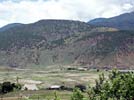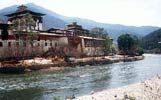 |
The PUNAKHA area is blessed with a temperate climate and drained by the Pochu (Male)
and Mochu (Female) rivers, the valley produces rich crops of rice and
fruits, including mangoes, bananas and oranges. |
Until
1955, Punakha served as the capital of Bhutan and even today, it is seat
of religion.
|
 |
In
1637, Zhabdung Ngawang Namgyal built PUNAKHA
DZONG at the junction of Pochu and Mochu
rivers to serve both religious and administrative centre for Bhutan. |
PUNAKHA
DZONG houses many sacred temples, including the temple, where the embalmed
of Zhabdrung Ngawang Namgyal lies in the state. In keeping with
tradition, the everyday rituals, including the serving of meals, are carried
out as they were done during Zhabdrung's lifetime.
|


